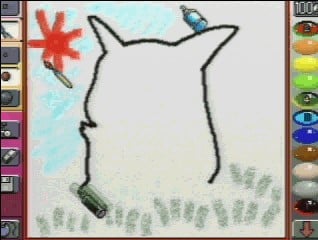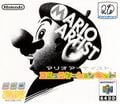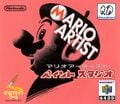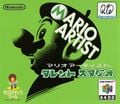Mario Artist (series): Difference between revisions
(Added imgs. :3) |
|||
| Line 2: | Line 2: | ||
'''Mario Artist''' is the series of eight games for the [[Nintendo 64DD]], released in Japan only. Of them, four were cancelled. | '''Mario Artist''' is the series of eight games for the [[Nintendo 64DD]], released in Japan only. Of them, four were cancelled. | ||
== ''Mario Artist: Paint Studio | ==''Mario Artist: Paint Studio== | ||
[[Image:mpaint.jpg|right|frame|''Mario Artist: Paint Studio''; drawing a picture of [[Pikachu]].]] | [[Image:mpaint.jpg|right|frame|''Mario Artist: Paint Studio''; drawing a picture of [[Pikachu]].]] | ||
''[[Mario Artist: Paint Studio]]'' (rel. Dec 1, 1999) is similar to ''[[Mario Paint]]'', but with more features. It was one of only two launch titles for the 64DD. Images could be imported from video tape or a [[Game Boy]] [[Game Boy Camera|Camera]] using the [[Nintendo 64]] [[Nintendo 64 Capture Cartridge|Capture Cartridge]]. | ''[[Mario Artist: Paint Studio]]'' (rel. Dec 1, 1999) is similar to ''[[Mario Paint]]'', but with more features. It was one of only two launch titles for the 64DD. Images could be imported from video tape or a [[Game Boy]] [[Game Boy Camera|Camera]] using the [[Nintendo 64]] [[Nintendo 64 Capture Cartridge|Capture Cartridge]]. | ||
| Line 8: | Line 8: | ||
This game often came bundled with the [[Nintendo 64 Mouse]]. | This game often came bundled with the [[Nintendo 64 Mouse]]. | ||
== ''Mario Artist: Talent Studio | ==''Mario Artist: Talent Studio== | ||
''[[Mario Artist: Talent Studio]]'' (rel. Feb. 23, 2000) allows users to insert pictures from cameras and videos onto 3-dimensional models, and then animate the models. Also, using the Capture Cartridge, which this game was bundled with, movies could be recorded by running a video camera through the Capture Cartridge. | ''[[Mario Artist: Talent Studio]]'' (rel. Feb. 23, 2000) allows users to insert pictures from cameras and videos onto 3-dimensional models, and then animate the models. Also, using the Capture Cartridge, which this game was bundled with, movies could be recorded by running a video camera through the Capture Cartridge. | ||
== ''Mario Artist: Communication Kit | ==''Mario Artist: Communication Kit== | ||
''[[Mario Artist: Communication Kit]]'' (rel. June 29, 2000) was an accessory to the other ''Mario Artist'' games. It allowed users to connect to [[Randnet]]'s [[Net Studio]], so users could share their creations in the other ''Mario Artist'' games with others. Unfortunately, the RandNet only ran for little over a year. | ''[[Mario Artist: Communication Kit]]'' (rel. June 29, 2000) was an accessory to the other ''Mario Artist'' games. It allowed users to connect to [[Randnet]]'s [[Net Studio]], so users could share their creations in the other ''Mario Artist'' games with others. Unfortunately, the RandNet only ran for little over a year. | ||
== ''Mario Artist: Polygon Studio | ==''Mario Artist: Polygon Studio== | ||
[[Image:MAPolygon.jpg|left|thumb|Editing a [[Mario]] polygon in ''Mario Artist: Polygon Studio''.]] | [[Image:MAPolygon.jpg|left|thumb|Editing a [[Mario]] polygon in ''Mario Artist: Polygon Studio''.]] | ||
''[[Mario Artist: Polygon Studio]]'' (rel. Aug. 29, 2000) allows users to construct and render 3-dimensional polygons, as the name suggests. This was the last Mario Artist game released. The game includes a special mode called Sound Bomber, where the player has to win as many [[microgame]]s as possible, all of them featuring the player's polygon model in some way. This mode is the precursor to the ''[[WarioWare, Inc.|WarioWare]]'' series. | ''[[Mario Artist: Polygon Studio]]'' (rel. Aug. 29, 2000) allows users to construct and render 3-dimensional polygons, as the name suggests. This was the last Mario Artist game released. The game includes a special mode called Sound Bomber, where the player has to win as many [[microgame]]s as possible, all of them featuring the player's polygon model in some way. This mode is the precursor to the ''[[WarioWare, Inc.|WarioWare]]'' series. | ||
== Cancelled Games == | ==Cancelled Games== | ||
*''Mario Artist: Game Maker | *''Mario Artist: Game Maker | ||
*''Mario Artist: Graphical Message Maker | *''Mario Artist: Graphical Message Maker | ||
*''Mario Artist: Sound Maker | *''Mario Artist: Sound Maker | ||
*''Mario Artist: Video Jockey Maker'' | *''Mario Artist: Video Jockey Maker | ||
< | |||
<center><gallery> | |||
Image:MACommunicationKit.jpg|<center>''Mario Artist: Communication Kit | |||
Image:MAPaintStudio.jpg|<center>''Mario Artist: Paint Studio | |||
Image:MATalentStudio.jpg|<center>''Mario Artist: Talent Studio | |||
</gallery></center> | |||
{{N64DD}} | {{N64DD}} | ||
{{Japan-Only}} | {{Japan-Only}} | ||
Revision as of 17:27, January 18, 2009
It has been requested that this article be rewritten and expanded to include more information.
Mario Artist is the series of eight games for the Nintendo 64DD, released in Japan only. Of them, four were cancelled.
Mario Artist: Paint Studio

Mario Artist: Paint Studio (rel. Dec 1, 1999) is similar to Mario Paint, but with more features. It was one of only two launch titles for the 64DD. Images could be imported from video tape or a Game Boy Camera using the Nintendo 64 Capture Cartridge.
This game often came bundled with the Nintendo 64 Mouse.
Mario Artist: Talent Studio
Mario Artist: Talent Studio (rel. Feb. 23, 2000) allows users to insert pictures from cameras and videos onto 3-dimensional models, and then animate the models. Also, using the Capture Cartridge, which this game was bundled with, movies could be recorded by running a video camera through the Capture Cartridge.
Mario Artist: Communication Kit
Mario Artist: Communication Kit (rel. June 29, 2000) was an accessory to the other Mario Artist games. It allowed users to connect to Randnet's Net Studio, so users could share their creations in the other Mario Artist games with others. Unfortunately, the RandNet only ran for little over a year.
Mario Artist: Polygon Studio
Mario Artist: Polygon Studio (rel. Aug. 29, 2000) allows users to construct and render 3-dimensional polygons, as the name suggests. This was the last Mario Artist game released. The game includes a special mode called Sound Bomber, where the player has to win as many microgames as possible, all of them featuring the player's polygon model in some way. This mode is the precursor to the WarioWare series.
Cancelled Games
- Mario Artist: Game Maker
- Mario Artist: Graphical Message Maker
- Mario Artist: Sound Maker
- Mario Artist: Video Jockey Maker


